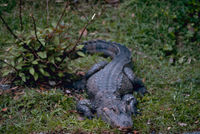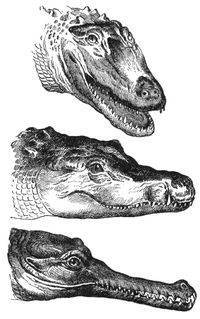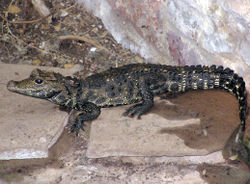|
Crocodilia |
||||||||
|---|---|---|---|---|---|---|---|---|
 |
||||||||
| Scientific classification | ||||||||
|
||||||||
|
Eusuchia Protosuchia † Mesosuchia † Sebecosuchia † Thalattosuchia † |
Crocodilia is an order of large reptiles that appeared about 220 million years ago. They are the closest living relatives of birds, as the two groups are the only survivors of the Archosauria.[1]
Contents |
Spelling
The group is often spelled 'Crocodylia' for consistency with the genus Crocodylus Laurenti, 1768. However, Richard Owen used the -i- spelling when he published the name in 1842, so by the usual rules of scientific classification his name has priority. In any case, the -i- spelling is a more accurate Latinization of the Greek κροκόδειλος (krokodeilos, literally "pebble-worm", referring to the shape and texture of the animal).
Description
Like mammals and unlike most other reptiles (with the notable exception of monitor lizards), crocodiles have a four-chambered heart; however, unlike mammals, oxygenated and deoxygenated blood can be mixed when the foramen of Panazzi is open, which bridges both ventricles in the heart. The foramen is typically only open during diving, in order to shunt blood away from the lungs. Their blood has shown to have strong antibacterial properties.
All crocodilians have, like Homo sapiens (humans), thecodont dentition (teeth set in bony sockets) but unlike mammals, they replace their teeth throughout life (though not in 'extreme' old-age). Juvenile crocodilians replace teeth with larger ones at a rate as high as 1 new tooth per socket every month. After reaching adult size in a few years, however, tooth replacement rates can slow to two years and even longer. Very old members of some species have been seen in an almost "edentulous" (toothless) state, after teeth have been broken and replacement slowed or ceased. The result of this is that a single crocodile can go through at least 3,000 teeth in its lifetime. Each tooth is hollow, and the new one is growing inside the old. In this way, a new tooth is ready once the old is lost.

Crocodilians have a secondary bony palate that enables them to breathe when partially submerged, even if the mouth is full of water. Their internal nostrils open in the back of their throat, where a special part of the tongue called the "palatal valve" closes off their respiratory system when they are underwater. This way they can open their mouths underwater without choking. Most reptiles lack a secondary palate, but some skinks (family Scincidae) have evolved a bony secondary palate too, to varying degrees.
The tongue is attached to the floor of its mouth, making it hard to move at all.
They lack a vomeronasal organ (yet it is detectable in the embryo) and a urinary bladder.
They have alveoli in their lungs and a unique muscular attachment to the liver and viscera that acts as a piston to breathing, separating the thoracic and abdominal cavities (similar to the diaphragm of mammals). Although tegu lizards have a primitive proto-diaphragm, separating the pulmonary cavity from the visceral cavity and allowing greater lung inflation, this has a different evolutionary history.
Like all reptiles they have a relatively small brain, but it is more advanced than in other reptiles. Among other things it has a true cerebral cortex.
Crocodiles are often seen lying with their mouths open, a behavior called gaping. One of its functions is probably to cool them down, but since they also do this at night and when it is raining, it is possible that gaping has a social function too.
The crocodile basic body plan is a very successful one. Their form is well-adapted to their semi-aquatic niche, which is why modern forms look similar today as they did when the dinosaurs were still around (though only to the semi-aquatic forms). Mammals too have adapted to this body plan at least once in history. One ancestral whales family, Ambulocetidae, was an aquatic predator living in rivers and lakes. Ambulocetids filled an ecological niche similar to the modern crocodiles.
They have a semi-erect (semi-sprawled) posture, holding their legs more directly underneath them than most other reptiles (the chameleons are probably the only reptiles with a more erect posture than Crocodylia). This makes it possible for some species to even gallop on land if necessary; an Australian species can reach a speed of over 16 km/h while galloping on an irregular forest floor. But their ancestors actually had a fully erect posture; their sprawling and semi-erect posture are secondary and evolved after they adapted to a life in water as ambush predators. Their the ankle bones (tarsals) are highly modified. In other words, their locomotion is not primitive, it is in fact specialised to their semi-aquatic lifestyle. Their distant ancestors were fast-moving terrestrial predators, like Junggarsuchus sloani. An extinct terrestrial species, Pristichampsus rollinatii, even had hoof-like toes.
As in many other aquatic or amphibian tetrapods, the eyes, ears, and nostrils are all located on the same plane. They see well during the day and may even have colour vision, plus the eyes have a vertical, cat-like pupil which also gives them excellent night vision. The iris is silvery (light reflecting layer of tapetum behind the retina greatly increases their ability to see in weak light) also makes their eyes glow in the dark. A third transperant eyelid, the nictitating membrane, protects their eyes underwater. However, they cannot focus under water, meaning other senses are more important when submerged under water.
While birds and most reptiles have a ring of bones around each eye which supports the eyeball (the sclerotic ring), the crocodiles lack these bones, just like mammals and snakes. The eardrums are located behind the eyes and are covered by a movable flap of skin. This flap closes, along with the nostrils and eyes, when they dive, preventing water from entering their external head openings. The middle ear cavity has a complex of bony air-filled passages and a branching eustachian tube. There is also a small muscle (which is also seen in gecko) next to or upon the stapes, the stapedius, which probably functions in the same way as the mammalian stapedius muscle does, dampening strong vibrations.
The gender of the juvenile is determined by the incubation temperature. This means crocodilians do not have genetic sex determnination (like us), but a form of environmental sex determination which is based upon temperature embryo's undergo early in their development.
The skin is covered with non-overlapping scales composed of the protein keratin (the same protein that forms hoofs, skin, horns, feathers, hair, claws and nails in other tetrapods), which are shed individually. On the head the skin is actually fused to the bones of the skull. There are small plates of bone, called osteoderms or scutes, under the scales. Just like a tree, crocodile osteoderms have annual growth rings, and by counting them it is possible to tell their age. Osteoderms are found especially on the back, and in some species also on the belly. The overlapping rows of scutes cover the crocodile's body from head to tail, forming a tough protective armor. Beneath the scales and osteoderms is another layer of armor, both strong and flexible and built of rows of bony overlapping shingles called osteoscutes, which are embedded in the animal's back tissue. The blood-rich bumpy scales seen on their backs acts as solar panels.
Their spool-shaped vertebrae in their ancestors went from being biconcave to having a concave front and a convex back in the modern forms. This made the vertebral column more flexible and strong, a useful adaptation if you are hunting in water.
They possess ribs of dermal origin restricted to the sides of the ventral body wall. The collar bone (clavicle) is absent.
Crocodiles and gharials have modified salivary glands on their tongue (salt glands), which are used for excreting excess salt ions from their body. Alligators and caimans have them too, but here they are non-functioning. This indicates that at some point the common origin of the Crocodylia were adapted to saline/marine environments. This also explains their wide disribution across the continents (i.e. marine dispersal). Species like the saltwater crocodile (C. porosus) can survive protracted periods of time in the sea, and can hunt prey within this environment.
Crocodylians are known to swallow stones, gastroliths ("stomach-stones"), which act as a ballast in addition to aiding post-digestion processing of their prey. The crocodiylian stomach is divided into two chambers, the first one is described as being powerful and muscular, like a bird gizzard. This is where the gastroliths are found. The other stomach has the most acidic digestive system of any animal, and it can digest mostly everything from their prey; bones, feathers and horns.

The upper and lower jaws are covered with sensory pits, seen as small, black speckles on the skin, the crocodile version of the lateral organ we see in fish and many amphibians. But they have a completely different origin. These pigmented nodules encase bundles of nerve fibers that respond to the slightest disturbance in surface water, detecting vibrations and small pressure changes in water, making it possible for them to detect prey, danger and intruders even in total darkness. These sense organs are known as DPRs (Dermal Pressure Receptors). While alligators and caimans only have them on their jaws, crocodiles have similar organs on almost every scale on their body. The function of the DPRs on the jaws are clear, but it is still not quite clear what the organs on the rest of the body in crocodiles actually do. They are probably doing the same as the organs on their jaws, but it seems like they can do more than that, like assisting in chemical reception or even salinity detection.
Evolution
When their extinct species and stem group are examined, crocodylians prove to have been a very diverse and adaptive group of reptiles. Not only are an ancient group of animals, at least as old as the dinosaurs, they also evolved into a great variety of forms. The earliest forms, the Sphenosuchians, evolved during the Late Triassic, and were highly gracile terrestrial forms built like greyhounds. Several terrestrial species during the Cretaceous evolved herbivory, such as Simosuchus clarki and Chimaerasuchus paradoxus. During the Jurassic and the Cretaceous marine forms in the family Metriorhynchidae such as Metriorhynchus evolved forelimbs that were paddle-like and had a tail similar to modern fish. Dakosaurus andiniensis a closely related species to Metriorhynchus had a skull that was adapted to eat large marine reptiles.
Eusuchia, a modern clade which includes the crown group Crocodylia, first appeared in the Lower Cretaceous of Europe. The recently-described fossil, Isisfordia duncani, lived approximately 95 to 98 million years ago, during the Cenomanian epoch of the Upper Cretaceous. Isisfordia is the second oldest known eusuchian, and the earliest crocodylian yet found in Australia. Eusuchians underwent a mass radiation during the Late Cretaceous and the Paleogene, in which they evolved into numerous forms, such as semi-aquatic dinosaur-eating species (Deinosuchus); hooved, terrestrial carnivores (Pristichampus), and 'hatchet'-shaped skulled forms (Baru).
n popular Culture
- Several science fiction movies have giant crocodilians as their stars, such as Lake Placid, DinoCroc, and the crocodile series.
Extinct species
- Superorder
Crocodylomorpha
- (unranked)
Sphenosuchia
- Family Terrestrisuchidae
Family Sphenosuchidae
- Family Terrestrisuchidae
- (unranked)
Crocodyliformes
- Family Shartegosuchidae
- (unranked)
Protosuchia
- Family Protosuchidae
- (unranked)
Mesoeucrocodylia
- Family Hsisosuchidae
Family Gobiosuchidae - Suborder
Thalattosuchia
- Family Teleosauridae
Family Metriorhynchidae
- Family Teleosauridae
- Suborder
Metasuchia
- (unranked)
Notosuchia
- Family Notosuchidae
Family Sebecosuchidae
Family Baurusuchidae
- Family Notosuchidae
- (unranked)
Neosuchia
- Family Trematochampsidae
Family Peirosauridae
Family Atoposauridae
Family Dyrosauridae
Family Pholidosauridae
Family Goniopholididae - Family Paralligatoridae
- (unranked) Eusuchia (see below)
- Family Trematochampsidae
- (unranked)
Notosuchia
- Family Hsisosuchidae
- (unranked)
Sphenosuchia
Modern species
See individual family pages for a full list of species.
- (unranked)
Eusuchia
- Genus Hylaeochampsa (extinct)
- Genus
Allodaposuchus (extinct)
- Genus Borealosuchus (extinct)
Genus Pristichampsus (extinct) - Superfamily
Gavialoidea
- Family
Gavialidae
- Genus Gavialis - Gharial/Gavial
Genus Tomistoma - False Gharial/Gavial
- Genus Gavialis - Gharial/Gavial
- Family
Gavialidae
- Superfamily
Crocodyloidea
- Family Mekosuchidae (extinct)
- Family
Crocodylidae
- Subfamily Crocodylinae - Crocodiles
- Superfamily
Alligatoroidea
- Family Nettosuchidae (extinct)
- Family
Alligatoridae
- Subfamily Alligatorinae - Alligators
- Subfamily Caimaninae - Caimans
- Genus Borealosuchus (extinct)
External links
- http://www.il-st-acad-sci.org/kingdom/rept007.html
- http://www.il-st-acad-sci.org/kingdom/rept007a.html
- Before Crocodiles, the Hairless Coyote
- Florida's Museum of Natural History's Crocodilians Natural History & Conservation site
- International Crocodile Rescue
- Mikko's Phylogeny Archive Crocodyliformes